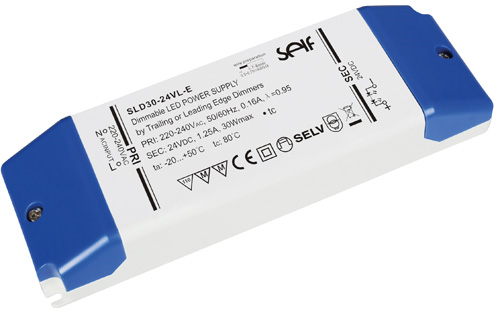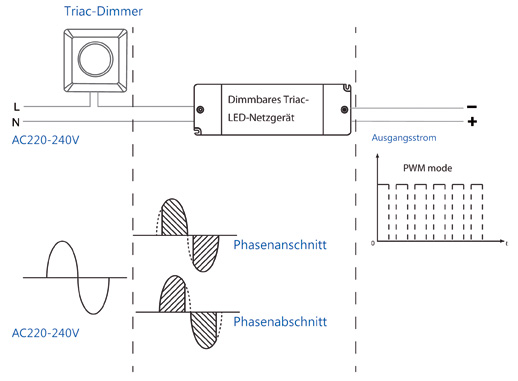
The challenges involved in dimming LEDs continue. One option for dimming without an additional control cable is leading edge/trailing edge dimming with a phase-dimmable power supply.
The Problem
A major problem with dimming LEDs in an electrical installation is surprisingly banal: how does the dimming command reach the LED power supply? With wired interfaces like 1-10V, DALI or KNX, extra control cabling to the power supply is required in addition to the mains power. Wireless solutions can be prone to faults, and many users would also like a classical built-in wall switch/dimmer in addition to smart controls on a phone or tablet. In many existing and new installations, however, a separate bus cable or control cable is not available.
Solution
Leading edge/trailing edge dimming with a triac dimmer offers the possibility of dimming via the L and N connections of the 230V mains supply, thus avoiding an additional control cable. Incandescent lamps are controlled directly in this way, switching on and off 100 times per second. LED applications can be operated with phase-dimmable LED power supplies.

For constant-current applications, e.g. lamps and spotlights, a relatively wide range of triac-dimmable LED power supplies is available.
For constant-voltage applications, however, like LED strips or modules, finding a phase-dimmable power supply is a challenge.
Tip: Schukat supplies phase-dimmable constant voltage power supplies from Self Electronics in the 15W and 120W power classes.
• These power supply units work with a pulse-width-modulated output and can be used in a wide range of applications. The PWM frequency has been increased to 4.3kHz to exclude any possibility of flicker on video recordings. New components and improved circuit design compensate for the disadvantages of the higher frequency: increasing switching losses and associated self-heating, as well as efficiency losses.
• Depending on the dimmer used, the power supplies can be dimmed from 100 percent to a minimum of 5 percent.
• A sufficiently large primary storage capacitor provides the power supply with the necessary energy, even with a heavily trimmed sine wave. An attenuating circuit has been added to keep the switch-on current, which is primarily affected by the capacitor, low.
• During dimming, not every half wave leads to a change in the DC output of the power supply. Special software evaluates the half-waves arriving from the triac dimmer over a specified time period before the PWM output is modified using a special algorithm. Compatibility problems with existing dimmers and resulting LED flicker can largely be excluded by the software and a special hardware solution in the primary circuit.
Conclusion: The LED power supplies from SELF Electronics stand out from the crowd with their high efficiency and long operational life.
Schukat electronic offers support in the search for a phase-dimmable power supply as well as advice on all power-supply matters. We supply the entire range of LED power supplies from Self Electronics, including low-profile 100W power supplies with a maximum installation height of 16.5mm. Additionally, Schukat also develops customer-specific solutions adapted for individual applications in close collaboration with both customer and manufacturer. Our sophisticated logistics system and high level of in-stock inventory in our logistics centre ensures fast delivery times for both small series and large-volume business.












